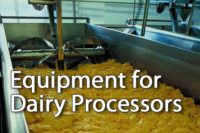
While not quite as envisioned in “I, Robot” or “The Jetsons,” robots are becoming increasingly common in food processing. The first robots were used for repetitive tasks such as palletizing skids, where they were not in direct contact with products. However, robots now are commonly being used for direct handling of foods, especially in ready-to-eat (RTE) applications such as pastries, handling cheese sticks, and snack chip processing. These may be simple “pick and place” robots, or they can be used for cutting and slicing, dispensing, or a variety of other automated tasks.
Manual handling of RTE foods creates a significant risk of contamination due to close contact with operator’s hands and clothing. Utilizing robots in these types of applications may reduce the risks of contamination by operators, but this creates other risks due to the design, operation, cleaning, and sanitizing of the robots. Yet, some robots have been designed to clean themselves and their surrounding frames.
To address the sanitary design requirements of the robots used in direct product contact, 3-A SSI introduced Standard 103-00 for Robot-based Automation Systems in 2016. This standard provides criteria for both the product contact and non-product contact surfaces of the robots, as well as programming requirements.
Robots typically consist of four main components: the robot base or arm that may move or articulate to transfer product from point A to point B; the “End Of Arm Tooling” (EOAT) that is like a hand or gripper in direct contact with the product; tool changers for handling different products; and the “dressing,” which consists of the hoses, vacuum lines, cabling and other external components required to operate the robot.
These components must be joined together in a sanitary manner to prevent crevices and microbial and vermin harborage points.
3-A Standard 103-00 references the criteria in 3-A General Standard 00-01, with the requirements common to the range of 3-A SSI standards for various sanitary equipment. However, robots have unique features that don’t exist in other typical sanitary equipment because they can adopt multiple positions.
Here are some of the key elements in the standard that apply to the cleaning and inspectability of robots:
- During cleaning, robot motion can be used to provide accessibility to surfaces for manual cleaning, clean-in-place (CIP), clean-out-of-place (COP), or surface inspection processes or draining.
- EOAT shall be CIPable or removable for COP or manual cleaning by the use of simple hand tools or by use of a tool changer. When EOAT assemblies are too large or heavy for manual handling, appropriate mechanical means for handling or the use of a tool changer should be provided by the fabricator or end user.
- All surfaces of the EOAT shall be inspectable.
- Robot motion may be utilized for effective CIP.
- Robot motion may be utilized to provide effective drainage.
Additionally, due to their motion, there are other considerations that are unique to robots.
- The sanitary design associated with the robot and EOAT shall take motion into consideration. The motion associated with the robot, robot system, or EOAT shall not defeat the robot system’s sanitary design.
- When drip trays are used for drip containment, the robot system motion shall be limited using safety-related means to only those areas where the drip trays are effective. (Refer to ANSI/RIA R15.06-2012, Part 1, 5.12, and Part 2, 5.4 for additional information regarding limiting robot motion).
- The methods used to limit motion must be verified and documented.
- The robot should have the ability to be programmed to allow for specific positions that ensure safe food handling.
Companies that provide the complete integrated system including the EOAT are eligible to obtain a 3-A Symbol authorization for the unitized assembly, which affirms that a 3-A SSI Certified Conformance Evaluator has verified conformance to the 3-A SSI standard. The 3-A Symbol authorization assists regulatory sanitarians in reviewing such equipment. Alternatively, companies that provide only the robot base/arm or EOAT may qualify to obtain a 3-A Replacement Parts and System Component Quality Certificate (RPSCQC). This attests that such component parts are compatible with criteria in the standard.
The complete 3-A Sanitary Standard 103-00 with all the requirements for Robot-based Automation Systems in food applications is available for purchase from 3-A SSI at www.3-a.org.


